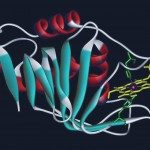Link to Pubmed [PMID] – 22251893
Biochim. Biophys. Acta 2012 Mar;1824(3):478-87
The three-dimensional structures of the long-chain mammalian scorpion β-toxin CssII from Centruroides suffusus suffusus and of its recombinant form, HisrCssII, were determined by NMR. The neurotoxin CssII (nCssII) is a 66 amino acid long peptide with four disulfide bridges; it is the most abundant and deadly toxin from the venom of this scorpion. Both native and recombinant CssII structures were determined by nuclear magnetic resonance using a total of 828 sequential distance constraints derived from the volume integration of the cross peaks observed in 2D NOESY spectra. Both nCssII and HisrCssII structures display a mixed α/β fold stabilized by four disulfide bridges formed between pairs of cysteines: C1-C8, C2-C5, C3-C6, and C4-C7 (the numbers indicate the relative positions of the cysteine residues in the primary structure), with a distortion induced by two cis-prolines in its C-terminal part. The native CssII electrostatic surface was compared to both the recombinant one and to the Cn2 toxin, from the scorpion Centruroides noxius, which is also toxic to mammals. Structural features such N- and C-terminal differences could influence toxin specificity and affinity towards isoforms of different sub-types of Na(v) channels.
